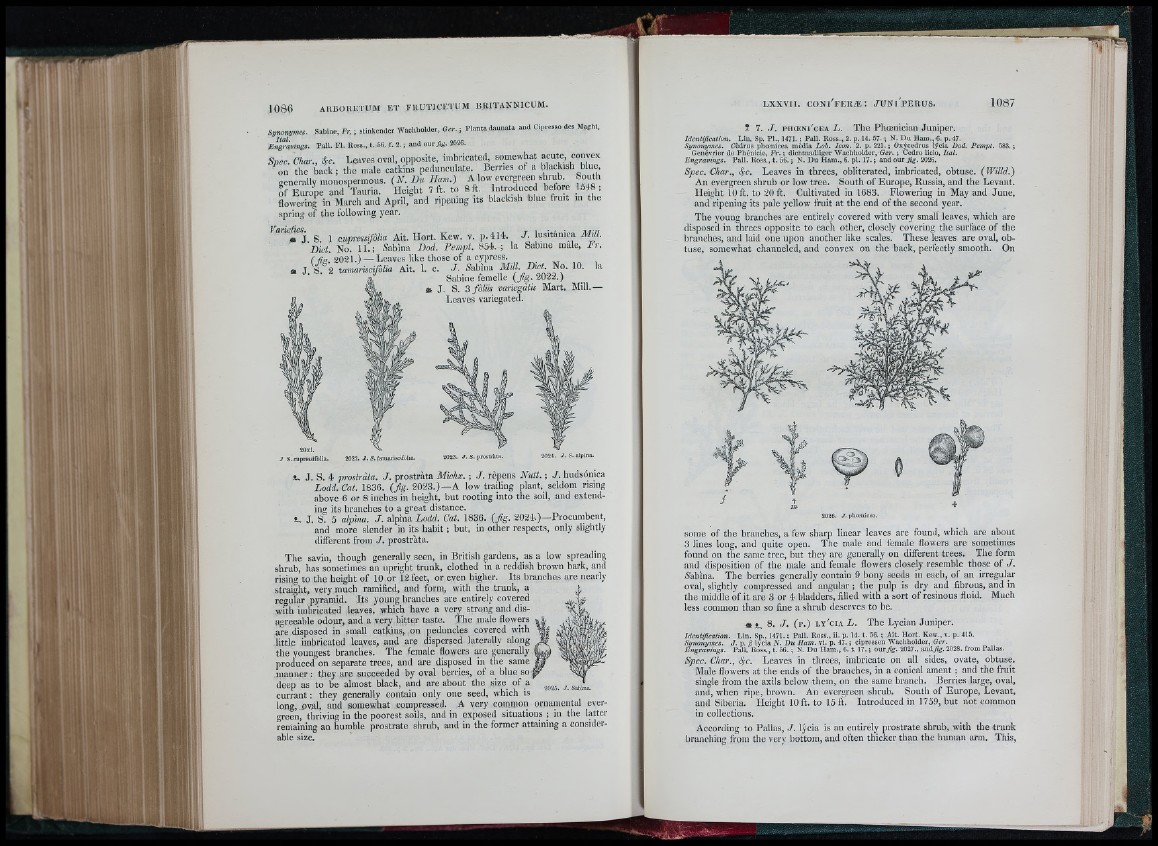
II
Synonymes. Sabine, Fr. ; stinkender Waehholcler, Ger. ; P ia n ta dannata and Cipresso des Maghi,
Engràvings. P ali. F l. Koss., t. 66. f. 2. ; and o u r * . 2026.
Spec. Char., f r . Leaves oval, opposite, imbricated somewhat acute, convex
on the b ack; the male catkins pedunculate. Bernes of a blackish blue
generally monospermous. (N .D u Ham.) A low evergreen shrub South
Sf Europe and Tauria. Height 7 ft. to 8 ft. Introduced before 1548;
flowering in March and April, and ripening its blackish blue frmt in the
spring of the following year.
VanetKS^ g j cupressifolia Ait. Hort. Kew. v. p. 414. J. lusitánica Mill.
'Diet. No! 11.; Sabina Dod. Pempt. 854. ; la Sabine male, Fr.
( f c . 2 0 2 1 .) — Leaves like those of a cypress. ,
« J S. 2 tam a n sc iß lia Ait. I. c. J- ¿abina M ill. Diet. No. 10. la
Sabine femelle {ß g . 2022.)
tt J . S. 3 foliis variegàtis Mart. Mill.—
Leaves variegated.
2021.
J S . cupressifòlia. 2022. J . S . ¿amariscifolia. 2023. J . S . p ro stràta . 2024. J . S. alpina.
J. rèpens Nutt. ; J. hudsónica
J . S. 4 prostràta. .7. prostràta Michx. ; J. rëpi
Lodd. Cat._________ 1836. (fig.„ 2023.)—, A low trailing _ ph plant,. seldom rising
' ' _
above 6 or 8 inches in height, but rooting into the soil, and extendlu
ing its branches to a great distance.
J. S. 5 alpina. J . alpina Lodd. Cat. 1836. (fig. 2024.)—Procumbent,
and more slender in its habit ; but, in other respects, only slightly
different from ,7. prostràta.
The savin, though generally seen, in British gardens, as a low spreading
shrub, has sometimes an upright trunk, clothed in a reddish brown bark, and
rising to the height of 10 or 12 feet, or even higher. Its branches are nearly
straight, very much ramified, and form, with the trunk, a
regular pyramid. Its young branches are entirely covered
with imbricated leaves, which have a very strong and disagreeable
odour, and a v e rj bitter taste. The male flowers
are disposed in small catkins, on peduncles covered with
little imbricated leaves, and are dispersed laterally along
the youngest branches. The female flowers are generally '
produced on separate trees, and are disposed in the same
manner; they are succeeded by oval berries, of a blue so |
deep as to be almost black, and are about the size of a
currant ; they generally contain only one seed, which is
long, oval, and somewhat compressed. A very common ornamental evergreen,
thriving in the poorest soils, and in exposed situations ; in the latter
remaining an humble prostrate shrub, and in the former attaining a considerable
size.
LXXVI I . c o n i ' f e r æ ; j u n i 'p e b u s . 1087
Î 7. ,T. pHOENi'cEA L . The Phoenician Juniper.
Identification, Lin. Sp. P l., 1471. ; Pall. Ross., 2. p. 14. 57. ; N. Du Ham., 6. p. 47.
Synonymes. Cèdrus phoenicea mèdia Lob. Icon. 2. p. 221.; Oxycedrus lÿcia Dod. Pempt. .583.;
Genévrier de Phénicie, Pr. ; dichtnadliger Wachholder, Ger. ; Cedro licio, Ital.
Engravings. P a ll. Ross., t. 56. ; N. D u Ham., 6. pl. 17. ; and our fig . 2026.
Spec. Char., Leaves in threes, obliterated, imbricated, obtuse. (Willd.)
An evergreen shrub or low tree. South o f Europe, Russia, and the Levant.
Height 10 ft. to 20 ft. Cultivated in 1683. Flowering in May and June,
and ripening its pale yellow fruit at the end of the second year.
The young branches are entirely covered with very small leaves, which are
disposed in threes opposite to each other, closely covering the surface of the
branches, and laid one upon another like scales. These leaves are oval, obtuse,
somewhat channeled, and convex on the back, perfectly smooth. On
2026. J . p hoen ic ea .
some of the branches, a few sharp linear leaves are found, which are about
3 lines long, and quite open. The male and iemale flowers are sometimes
found on the same tree, but they are generally on different trees. The form
and disposition of the male and female flowers closely resemble those of J.
Sabina. The berries generally contain 9 bony seeds in each, of an irregular
oval, slightly compressed and angular ; the pulp is dry and fibrous, and in
the middle of it are 3 or 4 bladders, filled with a sort of resinous fluid. Much
less common than so fine a shrub deserves to be.
S. J. (p .) L v ' c i A L . The Lycian Juniper.
Identification. L in . Sp., 1471. ; Pall. Ross., ii. p. 14. t. 66. ; Ait. Hort. Kew., v. p. 415.
Synonymes. J . p. S lÿcia N . D u Ham. vi. p. 47. ; cipressen Wachholder, Ger.
Engravings. Pall. Ross., t. 56. ; N. Du Ham., 6. t. 17. ; o u r * . 2027., a n d * 2028. from Pallas.
Spec. Char., 4c. Leaves in threes, imbricate on all sides, ovate, obtuse.
Male flowers at the ends of the branches, in a conical ament ; and the fruit
single from the axils below them, on the same branch. Berries large, oval,
and, when ripe, brown. An evergreen shrub. South of Europe, Levant,
and Siberia. Height 10 ft. to 15 ft. Introduced in 1759, but not common
in collections.
According to Pallas, .7. lycia is an entirely prostrate shrub, with the trunk
branching from the verv bottom, and often thicker than the human arm. This,